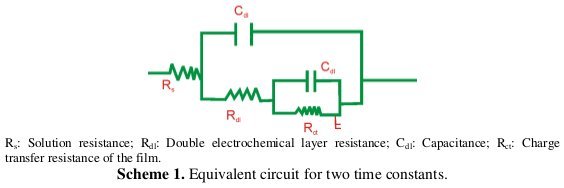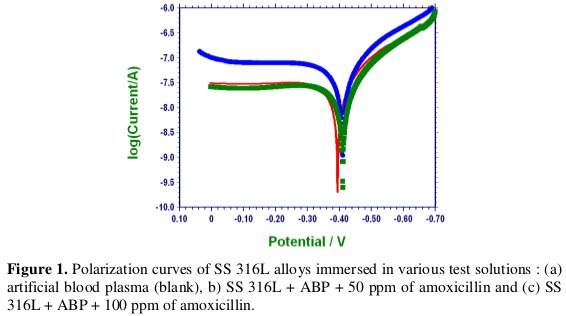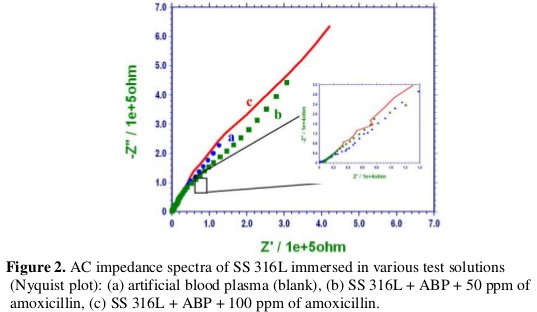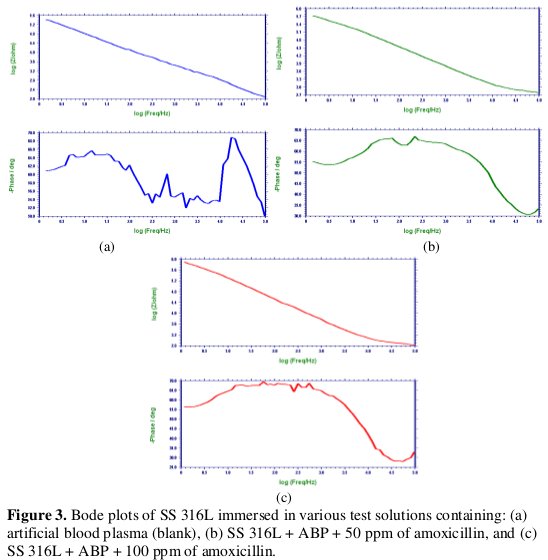Serviços Personalizados
Journal
Artigo
Indicadores
Links relacionados
Compartilhar
Portugaliae Electrochimica Acta
versão impressa ISSN 0872-1904
Port. Electrochim. Acta vol.31 no.1 Coimbra jan. 2013
https://doi.org/10.4152/pea.201301033
Corrosion Behaviour of SS316L in Artificial Blood Plasma in Presence of Amoxicillin
S. John Mary1,* and S. Rajendran2
1 Department of Chemistry, Loyola College, Chennai, Tamil Nadu, India
2 Department of Chemistry, RVS School of Engineering & Technology, RVS Nagar, Dindigul-624005, Tamil Nadu, India
Abstract
An investigation about the corrosion resistance of SS316L alloys in artificial blood plasma environments in presence and absence of amoxicillin has been carried out by using electrochemical techniques. Tested alloys included 18% Cr, 12% Ni, 2.5% Mo, < 0.03 C, balance iron, using artificial blood plasma solution. Electrochemical techniques included potentiodynamic polarization curves, linear polarization resistance and AC impedance spectroscopy. Different techniques have shown that generally speaking, SS316L alloys show a more corrosion resistance in artificial blood plasma in the presence of 100 ppm amoxicillin than in the presence of 50 ppm of amoxicillin and in the absence of amoxicillin. Their corrosion resistance is increased as the quantity of amoxicillin is increased in artificial blood plasma.
Keywords: SS316L, artificial blood plasma, amoxicillin, corrosion.
Introduction
Amoxicillin is a N-S heterocyclic compound containing five oxygen atoms, three nitrogen atoms and one sulphur atom. Hence it is expected to act as a good inhibitor. Organic inhibitors decrease the corrosion rate by adsorbing on the metal surface and blocking the active sites by displacing water molecules and form a compact barrier film on the metal surface. Amoxicillin is an antibiotic with π-electrons, hetero atoms, S, N and O. The molecule is high enough (molecular mass 365.4) and sufficiently planar to block more surface area (due to adsorption). These factors favour the interaction of amoxicillin with the metal [1]. SS316L alloys are the most commercially successful implantation material in biomedical. SS316L alloys are widely used as orthopedic implant materials in clinical practice; stainless steel is one of the representatives of metallic biomaterials. This is mainly due to their good corrosion resistant properties. The stainless steels typically used in medicine are austenitic stainless steels. These stainless steels contain 17-20% Cr, 13-15% Ni, 2-3% molybdenum and small amount of other elements. The notation "L" indicates that the steel has low carbon content (< 0.03%) and is therefore not susceptible to intergranular corrosion; due to precipitation of Cr-carbides at the grain boundaries, stainless steel implants are used as temporary implants to help bone healing, as well as fixed implants such as artificial joints. In terms of corrosion resistance in the human body, stainless steels are inferior compared to cobalt, chromium and titanium alloys. However large amount of stainless steels are used for implant devices because they are less expensive than cobalt -chromium alloys, pure titanium and titanium alloys [2]. This study was designed to investigate the effect of SS316L in artificial blood plasma in presence of amoxicillin. People who have undergone implantation with weak immunity power are recommended by medical practitioners to take amoxicillin antibiotics to improve the immunity. By taking amoxicillin antibiotics orally increases the immunity level in our body. This study reveals whether the implantation material SS316L is affected or corroded due to the intake of amoxicillin. Different concentrations of the inhibitor (amoxicillin) were prepared and their inhibition efficiency in artificial blood plasma has been investigated.
Experimental
Preparation of specimens
The metal specimen named SS316L has been chosen for the present study. The composition of SS 316L was (wt%) 18Cr, 12Ni, 2.5Mo, <0.03C and the balance iron [3]; the specimens were polished to a mirror finish, degreased with trichloroethylene, and used for weight loss study and surface examination studies. For potentiodynamic polarization studies, SS316L encapsulated in Teflon, with an exposed cross section of 5 mm diameter, was used as the working electrode. The working electrode surface was polished to a mirror finish and was degreased with trichloroethylene.
Solution preparation
The chemical composition of the artificial blood plasma according to PN-EN ISO 10993-15 standard (g/l distilled water) was NaCl 6.8, CaCl2 0.200, KCl 0.4, MgSO4 0.1, NaHCO3 2.2, Na2HPO4 0.126, NaH2PO4 0.026.
Potentiodynamic polarization studies
The polarization studies were carried out in a three-electrode cell assembly, using SS316L as the working electrode, platinum as the counter electrode and saturated calomel electrode (SCE) as the reference electrode. Electrochemical impedance and polarization curve measurements were achieved using H & CH model CHI 660A provided with iR compensation facility; polarization curve measurements were carried out at scan rate of 0.01 v/sec. The exposed area (1 cm2) was mechanically polished with a series of emery sheets of variable grade. The samples were thoroughly washed with double distilled water before insertion in the cell. During the polarization study, the scan rate (V/s) was 0.01; hold time at Ef(s) was zero and quit time (s) was 2. A three electrode cell assembly is shown in Scheme 1.

AC impedance spectra
AC impedance spectra were recorded in the same instrument used for polarization study using the same type of three electrode cell assembly. The real part Z' and imaginary part Z'' of the cell impedance were measured in Ohms for various frequencies. The charge transfer resistance (Rt) and double layer capacitance (Cdl) values were calculated.


AC impedance spectra were recorded with initial E(v) = 0; high frequency (Hz) = 1×105; low frequency (Hz) = 10; amplitude (V) = 0.005; and quit time (s) = 2.
Results and discussion
Analysis of potentiodynamic polarization curves
Polarization study has been used to confirm the formation of protective a film on the metal surface during the corrosion inhibition process [5]. If a protective film is formed on the metal surface, the linear polarization resistance (LPR) increases and the corrosion current value (Icorr) decreases.
The potentiodynamic polarization curves of SS 316L immersed in artificial blood plasma in the absence and presence of amoxicillin are shown in Figs. 1(a) to 1(c).

Corrosion parameters, namely corrosion potential, Ecorr, Icorr, Tafel slopes, ba, bc, and LPR are given in the Table 1.

When the SS 316L is immersed in artificial blood plasma in absence of amoxicillin the corrosion potential is -410 mV vs. SCE (Fig. 1(a)). The LPR value is 0.825 × 106 Ohm cm2 and the corrosion current (Icorr) is 6.097 × 10-8 A/cm2. The Tafel slopes (bc = 154 mV/decade, ba = 460 mV/decade) indicate that the rate of change of corrosion current with potential is much higher during the anodic polarization than during the cathodic polarization. During anodic polarization an oxide film is formed on the metal surface in presence of SS 316L.
The polarization study reveals that the corrosion resistance of SS 316L in artificial blood plasma increases in presence of 50 ppm of amoxicillin. When SS 316L is immersed in ABP in presence of 50 ppm of amoxicillin the corrosion potential is shifted from -410 to -394 mV vs. SCE Fig. 1(b). The Tafel slopes (bc = 153 mV/decade, ba = 583 mV/decade) indicate that the rate of change of corrosion current with potential is much higher during anodic polarization than during the cathodic polarization. It shows that in presence of amoxicillin it acts as better corrosion resistance than in absence of amoxicillin. Further the LPR value increases from 0.825×106 Ohm cm2 to 1.64×106 Ohm cm2. The corrosion current (Icorr) decreases from 6.097×10-8 A/cm2 to 3.216×10-8 A/cm2. Thus the polarization study confirms the formation of a protective film on the metal surface.
When 100 ppm of amoxicillin are added, the corrosion potential is increased from -410 (in absence of amoxicillin) and decreased from -394 (in presence of 50 ppm of amoxicillin) to -411 mV vs. SCE Fig. 1(c). LPR value increases from 0.825×106 (in absence of amoxicillin) and 1.64×106 (in presence of 50 ppm of amoxicillin) to 1.86×106 Ohm cm2 and Icorr value decreases from 6.097×10-8 (in absence of amoxicillin) and 3.216×10-8 (in presence of 50 ppm of amoxicillin) to 2.740×10-8 Ohm cm2. Thus the polarization study leads to the corrosion resistance of SS 316L in ABP in the following decreasing order:
SS 316L + ABP + 100 ppm of amoxicillin > SS 316L + ABP + 50 ppm of amoxicillin > SS 316L + ABP
AC impedance spectra
AC impedance spectra have been used to confirm the formation of a protective film on the metal surface [6]. If a protective film is formed on the metal surface, charge transfer resistance (Rt) increases, double layer capacitance value (Cdl) decreases and the impedance log(z/Ohm) value increases [7,8].
The AC impedance spectra of metal specimens immersed in artificial blood plasma in the absence and presence of 50 ppm and 100 ppm of amoxicillin are shown in Fig.2 (a,b,c) (Nyquist plots) and Fig.3 (a,b,c) (Bode plots).


The AC impedance parameters namely charge transfer resistance (Rt) and double layer capacitance (Cdl) derived from Nyquist plots are given in Table 2.

The impedance log (z/Ohm) values derived from Bode plots are given also in Table 2.
SS 316L immersed in artificial blood plasma in absence and in presence of amoxicillin
When SS 316L is immersed in ABP in absence of amoxicillin, the charge transfer resistance Rt is 129200 Ohm cm2. The double layer capacitance value is 3.94×10-11 F/cm2 (Fig. 2(a)). The impedance value is 5.4 (Fig. 3(a)). Bode phase diagram on Fig. 3(a) shows two time constants; a highly capacitive, typical of passive materials, suggests that the film formed on the alloy is more stable. The phase angle approaches 67°. The equivalent circuit is shown in scheme 1 [9,10]. It is inferred that SS 316L is more corrosion resistant in ABP. The oxide layer formed on SS 316L is more compact and less fragile [9,10].
When SS 316L is immersed in ABP containing 50 ppm amoxicillin, the charge transfer resistance Rt increases from 129200 Ohm cm2 to 309200 Ohm cm2 Fig. 2(b). The Cdl value decreases from 3.94×10-11 F/cm-2 to 1.64×10-11 F/cm-2.
Bode phase diagram shown in Fig. 3(b) shows that the diameter of the semicircle is increased so the corrosion resistance is increased. Corrosion rate is decreased. This is further supported by the phase angle, which is 68°. The impedance value log (z/Ohm) increases from 5.4 to 5.7 [11-13].
When 100 ppm amoxicillin is added the Rt value increases from 129200 (in absence of amoxicillin) and 309200 (in presence of 50 ppm of Amoxicillin) to 423800 Ohm cm2 Fig. 2(c). The Cdl value decreases from 3.94×10-11 (in absence of amoxicillin) and 1.64×10-11 (in presence of 50 ppm of amoxicillin) to 1.2×10-11 F/cm2. The impedance value increases from 5.4 (in absence of amoxicillin) and 5.7 log(z/Ohm) (in presence of 50 ppm of amoxicillin) to 5.8 log(z/Ohm).
Through the impedance Bode plot one can see that as the value of the frequency increases the impedance value decreases sharply being the slope of the straight line almost 0.5. This is a characteristic of a stable film formed on the surface of a metal during corrosion protection process. This is further supported by the phase angle of Bode plot. The value of the phase angle is 69°. Thus AC impedance spectral study reveals that the corrosion resistance of SS 316L in ABP is in the following decreasing order:
SS 316L + ABP + 100 ppm Amoxicillin > SS 316L + 50 ppm Amoxicillin > SS 316L + ABP
References
1. Harikumar S, Karthikeyan S, Narayanan S. Int J Chem Tech Res. 2012;4:1077. [ Links ]
2. Talha Mohd, Behera CK, Sinha P. J Chem Pharm Res. 2012;4:203. [ Links ]
3. Gurapp I. Mater Characterization. 2002;49:7379. [ Links ]
4. Kajzer W, Krauze A, Walke W, Marciniak J. J Achiev Mater Manuf Eng. 2008;31. [ Links ]
5. Nazeer AA, Fouda AS, Ashno EA. J Mater Environ Sci. 2011;2:24. [ Links ]
6. Thangam YY, Kalanithi M, Anbarasi CM, Rajendran S. Arab J Sci Eng. 2009;34. [ Links ]
7. Abdullah M. Corrosion Sci. 2004;466:1981. [ Links ]
8. Rajendran S, Uma V, Krishnaveni A et al. Arab J Sci Eng. 2009;34. [ Links ]
9. Castaneda IE, Gonzalez-Rodriguez JG, Dominguez G et al. Int J Electrochem Sci. 2011;6:404-418. [ Links ]
10. Application note on Basics of Electrochemical impedance spectroscopy by Gamry Instruments. [ Links ]
11. Antony N, Sherine HB, Rajendran S. Arab J Sci Eng. 2010;35:41. [ Links ]
12. Rajendran S, Devi KM, Regis APP et al. Zastita Materijala. 2009;50:153. [ Links ]
13. Raji A, Rajendran S, Prabha PS et al. Zastita Materijala. 2009;50:131. [ Links ]
Acknowledgement
The authors are thankful to their respective management and to UGC for their encouragement and to Mr. S. Elango for his computer aided design.
*Corresponding author. E-mail address: s_johnmary@yahoo.com
Received 27 November 2012; accepted 12 February 2013














